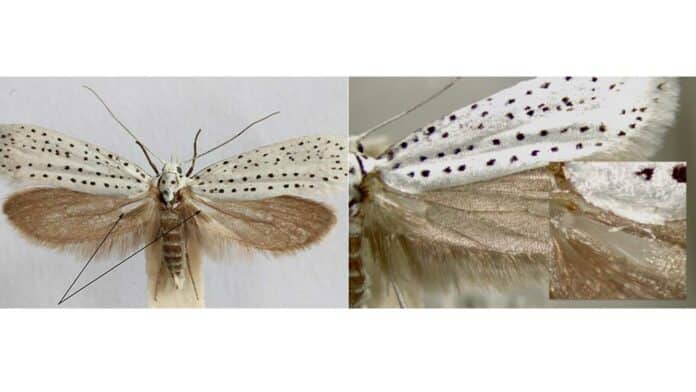Moths of the genus Yponomeuta possess wingbeat-powered tymbals that use sequential snap-through instabilities for sound production. The resulting bursts of clicks serve as an ultrasound protection mechanism against bats.
Scientists have recently uncovered a unique defense mechanism in ermine moths of the genus Yponomeuta against their predators, bats, involving ultrasonic clicking sounds produced during flight.
These moths produce clicks twice per wingbeat cycle using a tiny corrugated membrane in their hindwings. Interestingly, ermine moths lack hearing organs, are unaware of this defense mechanism, and cannot control it using muscles.
In a study, an interdisciplinary team from Bristol demonstrated how individual ridges of the corrugated membrane snap through during flight wing folding. This sudden action vibrates an adjacent membrane, significantly amplifying the strength and direction of the sound produced. Termed as an ”aeroelastic tymbal,” this passive mechanism enhances the moth’s acoustic defense without requiring active control.
Through this study, scientists aimed to understand how the corrugations in these tymbals can buckle and snap through in a choreographed way to produce a chain of broadband clicks. They uncovered the biomechanics that trigger the buckling sequence and shed light on how the clicking sounds are emitted through tymbal resonance.
Hernando Mendoza Nava, the study’s lead author, investigated the mechanics of the aeroelastic tymbal while pursuing his Ph.D. at the EPSRC Centre for Doctoral Training in Advanced Composites for Innovation and Science of the Bristol Composites Institute (BCI). He explained, “Sound production and radiation are connected to mechanical vibration, like in a drum or loudspeaker.
“In ermine moths, snap-through buckling events act like drumbeats on the edge of a tymbal drum, causing a larger portion of the wing to vibrate and emit sound. As a result, these tiny tymbals can produce ultrasounds equivalent to a lively human conversation.”
Mendoza used advanced techniques from biology and engineering mechanics to uncover the aeroelastic tymbal’s mechanics. By characterizing the wing’s morphology and material properties and conducting detailed computer simulations, he matched recorded moth signals in frequency, structure, amplitude, and direction.
Rainer Groh, Senior Lecturer in Digital Engineering of Structures at the BCI, added: “The integration of various methods across the sciences with a consistent information flow across discipline boundaries in the spirit of ”team science” made this study unique and a success. In addition, without the amazing modern capabilities in imaging, data analysis, and computation, uncovering the mechanics of this complex biological phenomenon would not have been possible.”
Alberto Pirrera, Professor of Nonlinear Structural Mechanics at the BCI, concluded: “In engineering design, nonlinear elastic responses, such as buckling and snap-through instabilities, have traditionally been perceived as failure modes to be avoided. In our research, we have advocated a paradigm shift and demonstrated that buckling events can be strategically leveraged to imbue structures with smart functionality or enhanced mass-efficiency. Yponomeuta’sYponomeuta’s aeroelastic tymbal embodies the concept of beneficial nonlinearity.”
The research team foresees that aeroelastic tymbals, through bioinspiration, will inspire new developments in morphing structures, acoustic structural monitoring, and soft robotics.
Journal Reference:
- Hernaldo Mendoza Nava, Marc W. Holderied, Alberto Pirrera, and Rainer M. J. Groh. Buckling-induced sound production in the aeroelastic tymbals of Yponomeuta. Proceedings of the National Academy of Sciences. DOI: 10.1073/pnas.2313549121
